Spocalc
Damon Rinard's free spoke length calculator |
Disclaimer: Harris Cyclery and sheldonbrown.com assume no responsibility for
the accuracy of results derived from this or any other spoke length calculator!
Translations:
French (see below) 
Russian 
|
|

|
|
|

Spocalc 2022


Spocalc 2022
(673KB) |
Matt Armbruster's updated version of Spocalc, easier to use and with macros that work in newer releases of Microsft Excel.
To download, click and hold, select "Save this link as..."; Select "Source" from the Format menu.
(Windows users, right click the link and choose "Save Target As...",)
|
Spocalc 2022 is the updated full-strength version and includes hub and rim databases. [No longer being updated, but we link to others which are being updated]
Spocalc (full strength version)

Spocalc
(174KB) |
To download, click and hold, select "Save this link as..."; Select "Source" from the Format menu.
(Windows users, right click the link and choose "Save Target As...",)
|
Version Française:
 
spocalc-fr.xls
(272KO) |
Pour télécharger, cliquez et tenez, sélectionnez <<Save this link as...>>; Sélectionnez <<Source>> du menu <<Format.>>
(Utiliseurs de Windows, cliquez avec le touche a droite et choisissez <<Save Target As...>>)
Merci à Vincent Vallet pour la traduction. |

SpocalcExpress

SpocalcExpress
(16KB) |
To download, click and hold, select "Save this link as..."; Select "Source" from the Format menu. (Windows users, right click the
link and choose "Save Target As...",) |
SpocalcExpress has no
hub database, no rim database, no instructions, no macros --
just the calculations that operate on the numbers you enter.
Thank Mark Schlueter for this great
idea. SpocalcExpress is just like the full
version of Spocalc, but less.
Enter one set
of hub and rim dimensions and SpocalcExpress
gives you the spoke length for radial, 1, 2, 3, 4, and any
other cross of your choice. Great for Quicksheet on your
Palm.
Version Française:
 
SpocalcExpress-fr
(16KB) |
Pour télécharger, cliquez et tenez, sélectionnez <<Save this link as...>>; Sélectionnez <<Source>> du menu <<Format.>>
(Utiliseurs de Windows, cliquez avec le touche a droite et choisissez <<Save Target As...>>)
Merci à Vincent Vallet pour la traduction. |


What is Spocalc?
Spocalc is a free
Excel spreadsheet I made that calculates spoke lengths for
wire-spoked wheels. There are lots of other spoke calculators
on the web (see the list I've
assembled). Some require you to measure your own rim and hub,
but Spocalc includes a database of over 350 hubs and
500 rims. The Spocalc database is also user-modifiable
and expandable so you can add more rims and hubs.
Some other spoke calculators require
you to re-enter the rim and hub dimensions again and again to
get different lengths for different numbers of crosses, but Spocalc
automatically gives you spoke lengths for 0, 1, 2, 3, 4 and
one other cross of your choosing (even a decimal number! Why would you want to do that?). Having several lengths can come in handy.
Print out Spocalc's calculator sheet and take it with you
when you buy spokes. If the shop doesn't have the right length for,
say, three cross, you can take a glance at the sheet and
decide if you could use four cross instead.
Matt Armstrong has updated Spocalc 2022, with ease-of use features. You must have Microsoft Excel 2007 or higher to run this version.. For other versions on this site, you must have Microsoft Excel 97 or higher (Windows, Mac or Android), LibreOffice Calc (free download, Windows or Linux, also see page about format conversion), or Gnumeric (free download, Linux only).
How to run Spocalc macros in Excel
Spocalc has a few macros to help speed data entry. Spocalc 2022 makes them easy to access, with buttons.
Opening the macros is a bit harder with earlier versions: you must choose "Enable.". If your virus checker disables them you can still use Spocalc without the macros - you just have to type in the numbers by hand.
In Excel 5.0, macros run from the Tools menu. In newer Excel versions which have ribbons instead of menus, there is no Tools menu, and also no Help menu. Clicking on the tiny question mark at the right-hand side of the ribbon and searching on "Using macros" led me to information:
- If the Developer tab is not in the ribbon, then in the File tab, click Options, and then the Customize Ribbon category.
- In the Main Tabs list, select the Developer check box, and "OK."
- Then, in the Developer tab of the ribbon, click on "Macro Security."
- In Macro Security, click on "Disable all macros with notification."
This choice will let you decide whether to run macros or not. A message bar may still come up, warning that macros are disabled. If so, click to enable macros.
Now to use a macro, first select a hub or rim by name, as described below. Then in the Developer tab, click on the Macros icon.: A list of macros will appear. Click on the appropriate macro.
macros run under Microsoft Excel (Windows, Mac) but...
Macros in OpenOffice


Screen Shots
1. Main calculator sheet
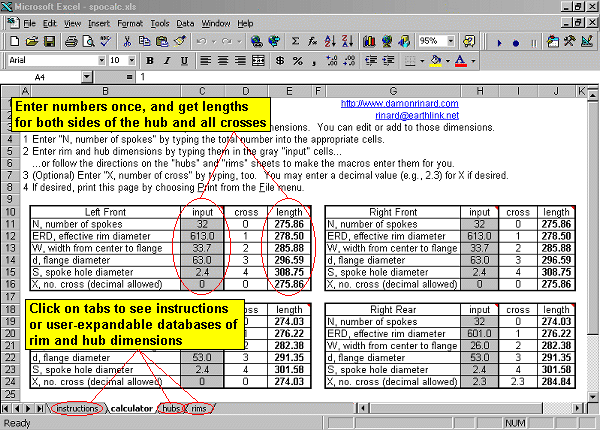
As you can see, by entering the hub and
rim dimensions once, you get spoke lengths for all crosses
automatically.
Although front wheels are usually
symmetrical, which would make the "Left Front" and
"Right Front" tables redundant, I've provided
separate left and right tables in case you are using a disc-brake hub or other dished front hub.
At the bottom you can see the tabs used
to view the instructions and the hub and rim database sheets.
2. Hub database sheet
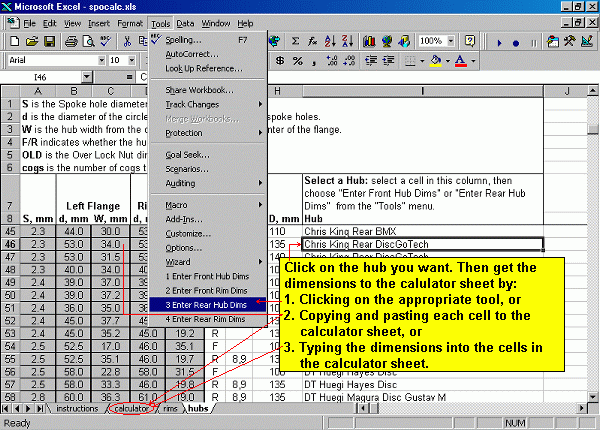
While you may certainly type in the
numbers by hand, here you can see how to use the macros to
enter all the hub data for you.
Important macro tip: you must first
select a cell in the "Select a Hub" column before
using the macro to enter the data.
3. Rim database sheet
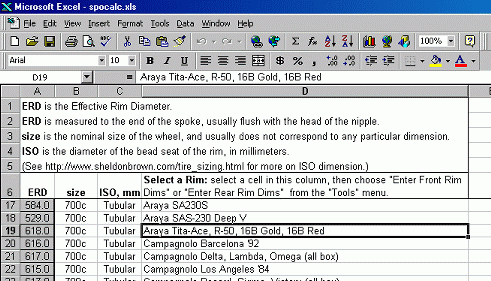
The rims sheet works just like the hubs
sheet: select the cell containing the rim you are using, then
click on the appropriate Macro (from the Tools menu, or in the Developer Tab of newer, beribboned Excel versions) to enter
the Effective Rim Diameter (ERD) on the calculator page, or
type the ERD number into the calculator page by hand.


How to Measure Hub and Rim Dimensions
There are five hub dimensions: dL, dR, S, WL, WR
John Allen's article on this site describes
additional ways to measure hubs and rims.
Measure twice and select spokes once!
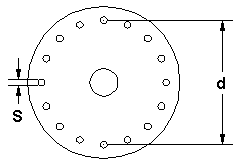 |
d, flange diameter is measured
between centers of opposite holes in the hub flange. It
is usually between 38 and 67 millimeters. Note that it is
NOT the outside diameter of the hub's flange. Left and
right flange diameters are often, but not always, the
same. Small errors in this measurement are important only with radial or near-radial spoking.
S, spoke hole diameter,
is the through diameter of any spoke hole. It is usually
2.6 mm.
|
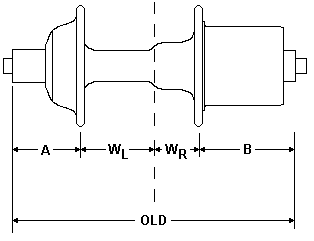
|
W, width from center to flange, may
differ between left and right sides of the hub. In this
illustration, WL and WR are the
dimensions you enter into the spreadsheet for the left
and right sides of the hub, respectively. You can use a
hub listed in Spocalc's database, or measure your own hub
by following these steps:
- Measure OLD (Over Locknut
Distance).
- Measure Dimension A.
- Measure Dimension B.
- WL = (OLD/2) - A.
- WR = (OLD/2) - B.
Not a lot of precision is needed in
the width dimensions. A few millimeters' error in width
will only lead to a fraction of a millimeter's error in
spoke length.
|
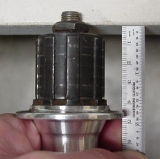 |
I usually measure A and B
dimensions by holding the hub locknut against a flat
surface (like the edge of my workbench), then measuring
from there back to the hub flange with a ruler or
caliper.
Note that you must
hold the locknut (not the axle end) against the edge.
Of course, I use two hands for
better accuracy. In this photo one hand is working the
camera!
|
There is one rim dimension:
ERD
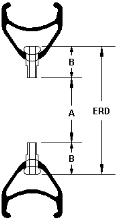 |
Effective Rim Diameter (ERD) is
the diameter on which you want the ends of the spokes to
lie. Most people prefer it near the end of the spoke
nipple. If you want to measure your own rim (recommended,
just to be sure), then follow these instructions:
- Insert two old spokes into
holes exactly opposite each other on the rim.
Count holes to be sure.
- Screw some nipples onto the
spokes.
- Pull them tight and measure
dimension A in the figure (the
diameter to the edge of the nipples, where the
spokes disappears into them). Do this at several
spots around the rim and average the
measurements.
- Measure the length of a nipple
(dimension B in the figure) and
add it twice (once for each nipple). The result
is Effective Rim Diameter (ERD). Thus,
ERD = A + 2B.
Effective Rim Diameter (ERD) is the
dimension you type into the spreadsheet for "ERD,
effective rim diameter". Of all the dimensions you
actually might measure, ERD is the most critical
dimension affecting spoke length, so it makes sense to
measure it a few times at different places around the
rim. Always count to make sure you use spoke holes that
are actually opposite each other!
John Allen's article describes two other ways to measure ERD. It isn't a bad idea to double-check!
|
 |
Off-Center or Asymmetric
rims make spoke tension more nearly equal when a wheel is dished. These rims require a slight adjustment for spoke
lengths. I don't know enough about Excel to make Spocalc
smart enough to compensate for rim offset, but I have two
work-arounds: the easy way and the exact
way.
The Easy Way:
Calculate spoke length as if the rim were symmetrical.
Then add 1mm to the right side and subtract 1mm from the
left side on rear wheels, or add 1mm to the disc side and
subtract 1mm from the non-disc side of front wheels.
|
The Exact Way: The
idea is to adjust the hub widths to mimic the rim
offset. (The change in spoke length is the same whether the
rim moves relative to the hub, or the hub moves relative to
the rim.) To do this, just change the left and right flange
offsets by the rim offset. Here's how to do it, step by step:
After entering your hub data into
Spocalc,
1. Calculate your rim's spoke-hole
lateral offset:
- Measure the rim width (W) and divide by two. This is the
rim half-width.
- Measure the distance from the near sidewall to the center
of the average spoke hole (L).
- Subtract this number from the rim half-width.
The result is the rim's spoke hole
lateral offset (or just rim offset), i.e. the amount by which
the rim reduces your wheel's dish. It is usually a couple of
millimeters. Thus,
2. Type over the "W, width from
center to flange" hub dimensions in Spocalc:
- Add the rim offset to the right flange width, and
- Subtract rim offset from the left flange width.
Spocalc automatically displays the new
spoke lengths.
Fatbike Rims and/or Skinny Hubs
Fatbike rims typically have the two rows of spoke holes far from the centerline. With some hubs, there will be hardly any bracing angle unless you cross spokes over to the far side of the rim. An e-bike hub motor may have narrow spacing between the flanges, so crossing the spokes over may also be useful. Use a rim whose spoke holes are not angled sharply toward the flange on their side. Add the offset between the centerline and the far row of spoke holes to the hub flange spacing when calculating spoke length -- same calculation as the "hard way" for asymmetric rims, described above, except that you have to do it separately for each side of the rim. .


Troubleshooting
Spocalc
The spoke lengths calculated
in Spocalc are based on pure 3D trigonometry: they are exact.
So unless I've made a mistake in the formulas, any error must
lie in the hub or rim measurements.
1. Check and double check
"ERD, effective rim diameter". Errors in ERD have a
direct effect on spoke length. ERD is also the easiest to get
wrong, since rims are rarely round when not built into
wheels, and you may measure at a large or small diameter. It
is definitely worth measuring ERD at several locations around
the rim and averaging. The idea is to reduce the effect of
any single measurement falling at a high or low spot. [I describe two additional ways to measure rim diameter in my article on this site -- John Allen]
2. Hub dimensions are less
critical: errors here have less effect on spoke length than
errors in ERD. With tangential lacing (several crosses, like
three or four), flange diameter (d) is less critical than
flange width (W). With radial lacing (not advisable with hub
brakes or rear wheels) flange diameter becomes relatively
more important.
3. Spoke-hole diameter (S) is
pretty inconsequential. Errors in spoke-hole diameter
contribute directly to errors in spoke length, but since the
errors are usually so small (much less than 1 mm) they rarely
make a significant difference in spoke length. Many formulas
ignore spoke-hole diameter entirely.
4. Also, it may seem obvious,
but check to be sure you entered the correct number of spokes
(N), and that you read the spoke length from the cell
corresponding to the correct number of crosses. I've made
both those mistakes before!
5. You can always download a current
copy of Spocalc or SpocalcExpress from this page. This will
fix problems like accidentally typing over hub or rim
dimensions on the database sheets, or typing over formulas on
the calculator sheet.
"Hey Damon, I got the macros
working. In the Excel [2000] program. Go under Tools, Macros,
then Security. Three options are there. I set mine on medium
security. Just thought I'd let you know in case others have
the same problem. Thanks for the help and the great spoke
calculator." -Bob


Related
Sites
Here are a few other pages on Damon
Rinard's Bicycle Tech Site you might be interested in:
Hub weights
Rim weights
Spoke weights
Wheel
stiffness
24 spokes in 36
hole hubs
Here are a few pages on other sites you
might be interested in:
Check spoke tension by ear, by John Allen.
Sheldon Brown's excellent Wheelbuilding page.
Tom Ace's beautiful "3 leading, 3
trailing" pattern.
Hed Wheels.
Complete aerodynamic drag numbers tabulated.
Humphries aero wheel summary. More aero drag numbers.
Rowland Cook's
unusual lacing patterns.
Wheel Fanatyk, many interesting blog posts and articles about wheelbuilding
Here are manufacturer's sites you might
be interested in:
American Classic -
site map.
DT
Swiss Bicycle Technology Menu
Mavic
rims and components
Sun
Rims
Tune
hubs
Sapim
spokes
Other
Spoke Length Calculators on the Web
(This list is updated as of January 2022 and now includes the highest-rated apps for iOS and Android devices. Search the Google Play site or Apple Apps Store for others. )
Copyright © 1997-2001


If you would like to make a link or bookmark to this page, the URL is:
https://www.sheldonbrown.com/rinard/spocalc.htm
Last Updated: by John Allen










